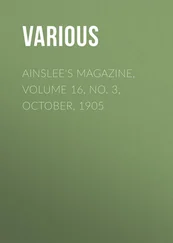Various - Donahoe's Magazine, Volume 15, No. 4, April, 1886
Здесь есть возможность читать онлайн «Various - Donahoe's Magazine, Volume 15, No. 4, April, 1886» — ознакомительный отрывок электронной книги совершенно бесплатно, а после прочтения отрывка купить полную версию. В некоторых случаях можно слушать аудио, скачать через торрент в формате fb2 и присутствует краткое содержание. Издательство: Иностранный паблик, Жанр: periodic, foreign_edu, на английском языке. Описание произведения, (предисловие) а так же отзывы посетителей доступны на портале библиотеки ЛибКат.
- Название:Donahoe's Magazine, Volume 15, No. 4, April, 1886
- Автор:
- Издательство:Иностранный паблик
- Жанр:
- Год:неизвестен
- ISBN:нет данных
- Рейтинг книги:5 / 5. Голосов: 1
-
Избранное:Добавить в избранное
- Отзывы:
-
Ваша оценка:
- 100
- 1
- 2
- 3
- 4
- 5
Donahoe's Magazine, Volume 15, No. 4, April, 1886: краткое содержание, описание и аннотация
Предлагаем к чтению аннотацию, описание, краткое содержание или предисловие (зависит от того, что написал сам автор книги «Donahoe's Magazine, Volume 15, No. 4, April, 1886»). Если вы не нашли необходимую информацию о книге — напишите в комментариях, мы постараемся отыскать её.
Donahoe's Magazine, Volume 15, No. 4, April, 1886 — читать онлайн ознакомительный отрывок
Ниже представлен текст книги, разбитый по страницам. Система сохранения места последней прочитанной страницы, позволяет с удобством читать онлайн бесплатно книгу «Donahoe's Magazine, Volume 15, No. 4, April, 1886», без необходимости каждый раз заново искать на чём Вы остановились. Поставьте закладку, и сможете в любой момент перейти на страницу, на которой закончили чтение.
Интервал:
Закладка:
"This great sea fight took place," said the narrator, "in the Bay of Dundalk, in the year 944. The account is given in an ancient Irish MS. with the title of ' Toruigheachd Cheallachain chaisil ,' – signifying the pursuit for the rescue of Ceallachan Cashel."
"Well what are your deductions, Mr. Mc.," queried the writer.
"The coincidence to my mind is this," said Mr. McGillicuddy, as his face brightened; "and it is a singular one I think, that here in this glorious and enlightened Republic, one thousand years later, the kinsman of this Munster prince, Rev. Denis O'Callaghan, when erecting his church, now all paid for, had in his employ the kinsmen of the four chiefs highest in command on that memorable occasion – viz: O'Keefe, O'Sullivan, O'Falvey and O'Connell, all professing the identical Christian creed their forefathers professed and practised. There are no barbarians here now, thank God, to hinder Christians from kneeling at their own shrine, and all as they chose, no matter how else they may differ on material and worldly questions. Here the kinsmen of these brave soldiers of the tenth century build temples to the Lord of Hosts, and are not called upon to defend them with their life's blood from the fire and sword of barbaric legions. Thus let us pray that with pure Christian foundations, the beloved union of States, – the Republic – may be in the quotation of Henry Grattan, ' esto perpetua .'
"
The Ursuline Convent of Tenos
Twenty-three years ago there started from France four Ursuline nuns with the intention of founding a convent of their order in the island of Tenos, in the Greek Archipelago. The first idea had been to found this establishment in Syra, the chief commercial town of the Cyclades; but insuperable difficulties turned their hopes to Tenos, known to the ancient Greeks as the island of Serpents. Nothing could be more picturesque and lovely than the island, nothing less civilized. These four ladies, of high courage and energy, left the shores of the most civilized country in the world with the small sum of six hundred francs, upon which they resolved to start a school of Catholic education and charity in an island which had ceased to be universally Catholic from the time of Venetian rule. Having gone over the ground and realized (only dimly) their enormous difficulties, the complete sacrifice they were compelled to make of all bodily comforts, and the unendurable conditions of existence they bravely faced, I can only compare their courage with that which formed the annals of the earliest stages of Christianity. Becalmed upon a whimsical sea, they arrived at Tenos a little before eight in the evening. Tenos was the spot selected, or rather its village, Lutra, because the bishop had consented to the erection of a convent in his diocese. To readers accustomed to the resources of civilized travelling the hour of arrival is an inconsequent detail. Not so even to-day in Tenos. Judge, then, what it must have been twenty-three years ago! Four delicately nurtured women had to face a dark, rocky road, more of the nature of a sheer precipice than a road, late at night upon mules. I made the same journey at mid-day and felt more dead than alive after it. There is positively not a vestige of roadway up the whole steep mountain pass, nothing but large rocks and broken marbles, though the traveller in search of the picturesque is amply repaid the discomfort of the ride. But compared with the village of Lutra, which was the destination of the nuns, this wild and dangerous-looking path is a kind of preliminary paradise. No word-painting of the most realistic school could do justice to the horror of Lutra to-day – and what must it have been there before the refining influence of those nuns touched it? This dirty stone-built and tumble-down village the four nuns entered at eight o'clock, when darkness covered its ugliness, but greatly increased its dangers. The first entrance winds under an intricate line of narrow stone arches, the pavement uneven, the mingling of odors unimaginable. Through this unearthly awfulness they bravely struggled and reached their destination at last. A Father from the neighboring community had heard of their expected arrival, and was already superintending the rough and hurried details of their reception. I saw the house which stands just as it was when the Ursuline nuns first made it their residence. A mud cabin containing two rooms: kitchen and dining-room, bedroom and chapel. The roof is made of stones thrown loosely over wooden beams placed far apart, the two rooms separated by a whitewashed arch instead of a door. There are no windows; but spaces are cut in the walls which served to let in the light and air, and at night were covered by shutters. Hail, rain, or snow, it was necessary to keep these spaces open by day in order to see, and it is not surprising that one of the nuns was soon prostrated by a dangerous fever. The beds were mattresses stuffed with something remarkably like potatoes, and laid on the mud floor at night, upon which the nuns slept a short, ascetic sleep.
Here they remained for some time, going among the villagers and soliciting that the poor would send their children to be taught. This the poor did, and gradually the children began to fill the kitchen of the mud cabin. If it rained during class umbrellas had to be put up as a protection under a nominal roof, just as the nuns had to sleep under umbrellas in wet weather. Indeed, sometimes it rained so hard that they were obliged to take up their mattresses at night, and seek a more sheltered spot elsewhere. At last the number of their charity pupils increased; and the bishop, as poor as they were almost, offered them the only asylum in his power, his own paternal home, also a mud cabin; but instead of two miserable rooms it contained four. This was an immense improvement, and the nuns felt like exchanging a cottage for a palace. But here the protection of umbrellas was still necessary, as the roof was also made of loosely set stones and beams. In time other nuns joined them from France, until they formed a community of eleven, with eighty village school children and one boarder. It grew daily more and more necessary that something should be done to raise money to build a convent. Their couches had been slowly raised from a mud floor to tables, upon which they slept the sleep of Trappists; but a proper establishment was now indispensable to the work they had laid themselves out to do. With this object, two nuns set out on a supplicating mission round the Levant. They were less successful than they had perhaps anticipated, for they returned after their arduous task only enriched by eight thousand francs. With this sum they were enabled to build a small portion of the present establishment; but building in a Greek island is slow and costly work. Each stone has to be carried up the long mountain pass from the quarries; the way is difficult, the men unaccustomed to prompt work.
However, in due time the nuns were enabled to leave the bishop's homely roof, where their chapel was a tiny closet separated from the class and dining-room by a curtain, and the beds the tables used during the day with umbrellas for a roof.
Two nuns later made the tour of France in search of funds, and were rewarded for their unpleasant undertaking by the sum of twenty-five thousand francs, which added something more to the building already commenced, and smaller sums, together with pupils, came afterwards. Now they have between fifty and sixty pupils who are paid for, and almost as large a number of charity children and orphans who are supported at the expense of the convent. These children are all Greeks or Levantines; but as the language of the Order is French, they speak French fluently.
So much for a general idea of the immense difficulties in the way of foundation, and for an outline of the personal sacrifices and admirable courage which has carried it through. I will now try to give an outline of what has been done. To begin with the island of Tenos, although extremely picturesque, with its marble rocks, its clear, bare hills shadowed lightly by purple thyme and gray olives and torrent beds in dry weather forming zigzag lines of pink-blossomed oleanders, fig-trees, mulberries, tall, feathery-headed reeds and orange and lemon trees, is as devoid of all the necessary adjuncts of modern existence as it is possible to imagine any place. As you approach it, it lies upon the deep, blue Mediterranean, a stretch of dimpled brown hills, curve laid inextricably upon curve, its apparent barrenness softened in the beauty of shape, as the morning sea mist, which has rested upon its base like a fine white veil, gradually lifts itself into the clouds. From an æsthetic point of view, the picture is admirable; but the least fastidious of travellers must at once recognize the almost impossibility of raising upon it anything like a comfortable European home. Yet, nevertheless, this gigantic feat is what the nuns, by a peculiar genius, patient perseverance, and severe economy, have accomplished. The two-roomed mud cabin of twenty-three years ago is now a tradition, and they have made themselves a lovely centre above the dirty village of Lutra. They have cultivated the stony, impoverished soil till their gardens are thickly foliaged by lemons, oranges, figs, pomegranates, cactuses, oleanders, oaks, olives, apples, pears, and apricots. These fruits are consumed in the convent partly, and the surplus is sold in Syra for a mere song, which, if they could export to England would yield them a profitable interest. Their gardens are arranged with great taste, French and English flowers blooming side by side with the luxuriant growths of the country. Nothing more lovely than the site upon which their mountain home is built can be imagined. The hills roll one above the other in different colors, and the valleys, with their stains of verdure and dusky foliages upon the red soil and marble rocks, are unfolded like a perpetual panorama. If you mount the terrace or the castra higher up – once a Venetian fortress – you will see the dreamy Mediterranean, responsive to the slightest emotions of the Eastern sky, and you will be surrounded by soft, blue touches of land breaking above its waves of intenser color – the Grecian Isles, Syra, with its white town half hidden by the cloud-shadowed hills, Syphona, a misty margin of gray upon the clear horizon, ancient Delos, so dim as to appear neither wholly sky nor land; desert Delos, with darker, fuller curves of land upon a silver edge of water, and nearest Mycono, a blending of the purest blues, with the famous Naxos behind washing which, whatever its mood in general, the Mediterranean is sure to take its own distinctive color – sapphire.
Читать дальшеИнтервал:
Закладка:
Похожие книги на «Donahoe's Magazine, Volume 15, No. 4, April, 1886»
Представляем Вашему вниманию похожие книги на «Donahoe's Magazine, Volume 15, No. 4, April, 1886» списком для выбора. Мы отобрали схожую по названию и смыслу литературу в надежде предоставить читателям больше вариантов отыскать новые, интересные, ещё непрочитанные произведения.
Обсуждение, отзывы о книге «Donahoe's Magazine, Volume 15, No. 4, April, 1886» и просто собственные мнения читателей. Оставьте ваши комментарии, напишите, что Вы думаете о произведении, его смысле или главных героях. Укажите что конкретно понравилось, а что нет, и почему Вы так считаете.












